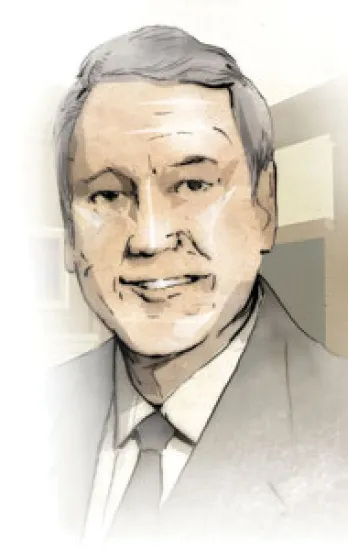Financial conditions last October were as difficult as anyone can remember for U.S. companies, especially those involved in financial services. Just ask William Wheeler, the CFO of MetLife.
The largest U.S. life insurer had seen its share price lose roughly half its value in the three-week bloodbath that followed the collapse of Lehman Brothers Holdings. But Wheeler didn’t waste time complaining about the shortsightedness of investors. Instead, he led MetLife in a secondary offering of common stock that raised $2.3 billion. Wheeler didn’t like tapping the market when his stock was cratering, but the benefits of the move were compelling in giving the company freedom of maneuver. When the U.S. Treasury extended capital support to the insurance industry under its Troubled Asset Relief Program last month, MetLife was able to say, “No thanks” to Uncle Sam.
“We had to make some strategic decisions in terms of capital management and liquidity to make sure we could succeed in this environment,” explains Wheeler, who doesn’t expect a quick economic rebound. “It took four to five years to get here, and it’s going to take four to five years to get it unwound.”
The definition of success has altered radically in corporate America lately. The recession entered its 17th month in April, making it the longest slowdown since the Great Depression. The contraction in economic output is the worst in 52 years. Corporate earnings were down by nearly one third, on average, in the first quarter from a year earlier. Companies looking to raise financing have had to pay sky-high interest rate spreads — if they have been able to tap the markets at all. Long gone are the days when businesses could count on a booming economy to generate double-digit earnings gains and rely on cheap credit to finance takeovers or big stock buybacks.
“This is the most volatile and challenging environment that I’ve seen in my time, and I’ve been doing this for 35 years,” says Louis Baldwin, CFO of Fort Worth, Texas–based oil and gas producer XTO Energy.
Top CFOs are rising to meet the challenge, though. These executives are moving to preserve liquidity by clamping down on costs, paying down debt where possible and taking advantage of market openings to raise capital. Such actions are crucial to ensuring that their companies not only survive the downturn, but also are in a position to increase their market share when the economy recovers.
Wheeler’s decision to strengthen MetLife’s balance sheet amid the financial meltdown is a major reason fund managers and analysts rank him as the best in the Insurance/Life sector, according to Institutional Investor’s seventh annual exclusive survey of America’s Best CFOs. “Wheeler has proven to be a strong CFO who makes tough decisions at the right time and focuses on the economics behind the company’s operations and not just the accounting,” says one fund manager.
We surveyed nearly 650 buy-side investment professionals at 350 institutions with combined assets of $5.9 trillion in U.S. equities and asked them to identify the top financial executives in the sectors they follow. Profiles of four of the best executives and their strategies for coping with the current market conditions appear on the following pages. Click here to view the complete ranking and other information, including the survey’s methodology.
Like Wheeler, XTO Energy’s Baldwin, who is voted first in Oil & Gas Exploration & Production, scrambled to anticipate negative market developments and give his company as much insurance as possible against the recession’s impact. XTO Energy extended the maturity of a good portion of its outstanding debt by issuing $2.25 billion of notes and bonds last August, only weeks before Lehman’s failure caused credit markets to seize up. (Lehman, ironically, lead managed the offering.) The company used financial futures last year to lock in the price for most of its oil and gas production this year, guaranteeing a gap price of $10.70 per thousand cubic feet, or nearly three times the market price of $3.67 early this month. Then in the first two months of this year, Baldwin entered into early settlement and resets of those hedges that raised $2.2 billion to pay down debt, and left the hedges on, albeit at lower rates.
“This is one of few times in my career that we have seen a global downturn as well as a downturn in commodity prices, and both will be long lasting,” Baldwin says, explaining his caution. With the outlook for energy prices remaining uncertain, the company in February also cut its exploration and development budget by $550 million, to $2.75 billion, to conserve cash. “Our strategy is to grow the company with substantially less than half of all of cash flow,” he says.
One company that is not likely to tap the capital markets anytime soon is Texas Instruments. The semiconductor manufacturer has worked hard in recent years to redesign its business model so the company is self-sustaining and can fund growth without borrowing. “We paid off the last debt we had two to three years ago and declined any opportunity to put new debt on our balance sheet,” notes TI’s CFO, Kevin March, who places first in Semiconductors. “Our company is now able to generate substantial levels of operating cash flow in excess of what we need to fund ongoing research and ongoing acquisitions.” The tactic has also enabled Texas Instruments to maintain its five-year-old stock buyback program: It spent $2.1 billion to repurchase 80 million shares in 2008.
Notwithstanding the company’s financial strength, the recession has had an impact on March’s work. He now spends about one third of his time on issues that previously needed little attention, including deciding how much inventory to hold and assessing customers’ ability to pay and suppliers’ ability to meet their commitments.
Marriott International has seen its business take a hit from the recession. Demand for the Bethesda, Maryland–based hotel operator’s lodgings is directly correlated with economic growth, and CFO Arne Sorenson, who ranks first in Gaming & Lodging, doesn’t see one recovering without the other. The company’s earnings fell 48 percent in 2008, to $362 million.
Sorenson has responded to the pressure by shoring up Marriott’s balance sheet. The company stopped its share buyback program in the fourth quarter of last year and pulled out of some planned 2009 hotel development projects — including deals in which it had already begun investing with partners — to conserve cash. “We decided we were better off writing off those investments rather than putting incremental capital in,” Sorenson explains. Investors, he adds, “have been interested in what are your credit ratios, what are the risks in terms of debt maturities, how strong are you and can you survive a redux of the Great Depression if it gets to be that bad.” Marriott isn’t abandoning growth altogether, though. The company plans to open 15 hotels in China by the end of 2010, giving it a total of 60, and double its presence in India, to 12 hotels.
MetLife is also looking to take advantage of its capital strength. With many insurers finding themselves financially constrained, and American International Group looking to shed operations to repay its government loans, MetLife will be looking to make opportunistic acquisitions and increase its market share, CFO Wheeler says.
“We have an internal saying, ‘Don’t waste a good crisis,’” he explains. That adage leaves Wheeler and other top CFOs with plenty to do.
Click on the names below to view their individual profiles.
Arne Sorenson, Marriott International
Louis Baldwin, XTO Energy
Kevin March, Texas Instruments
William Wheeler, MetLife






